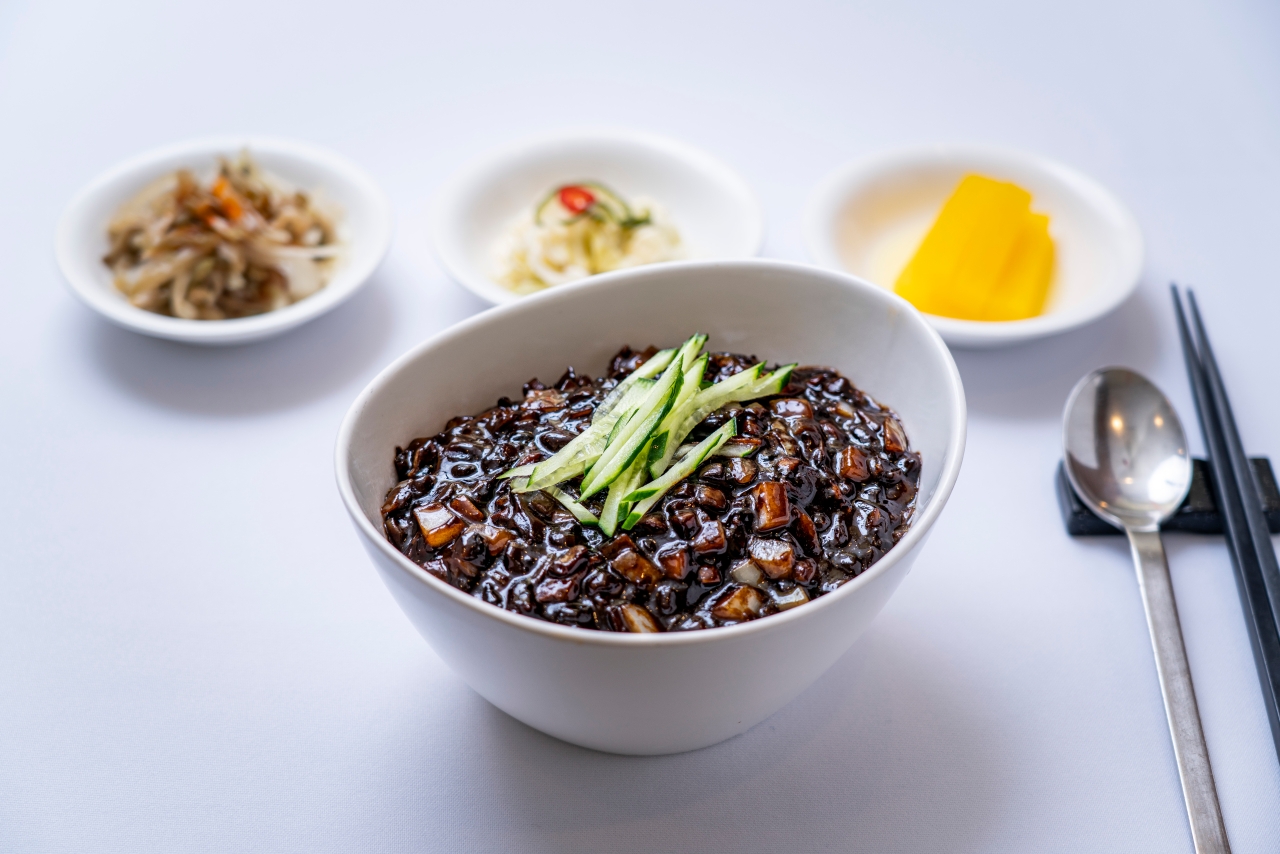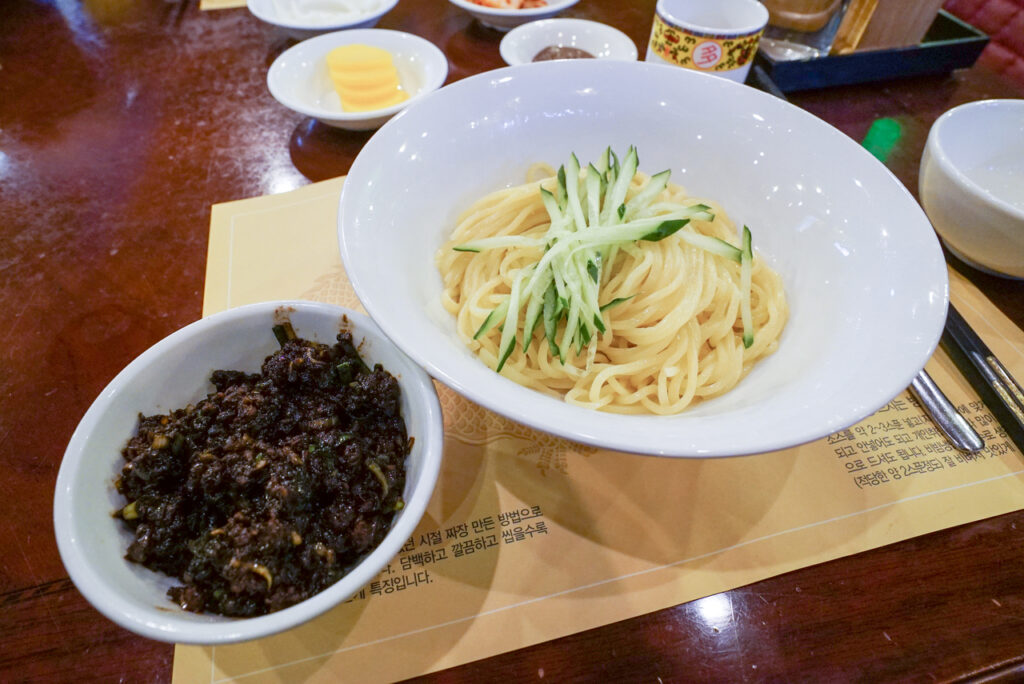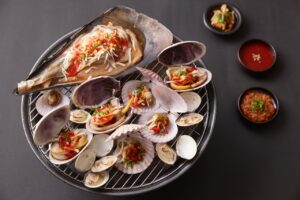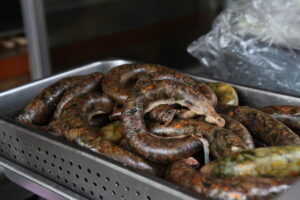
Jjajangmyeon1 - ⓒ한국관광공사 사진갤러리-살롱드베이커
What is Jjajangmyeon?
Jjajangmyeon (짜장면) is a popular Korean-Chinese noodle dish that features a savory black bean sauce served over wheat noodles. It’s a comfort food enjoyed by many in South Korea and is often ordered from Chinese restaurants or delivered as takeout. The dish has a rich and satisfying flavor profile, making it a beloved choice for both casual meals and special occasions.
Key Characteristics of Jjajangmyeon:
- Black Bean Sauce: The defining feature of jjajangmyeon is its thick and glossy black bean sauce. This sauce is made from black bean paste (chunjang), which is created by fermenting soybeans and roasted wheat flour. It imparts a deep umami flavor to the dish.
- Wheat Noodles: The noodles used in jjajangmyeon are typically made from wheat flour. They are often chewy and have a pleasant texture that complements the sauce.
- Protein and Vegetables: Jjajangmyeon is often prepared with diced pork or other proteins like seafood. The dish is also loaded with diced vegetables such as onions, zucchini, and potatoes, which are sautéed in the black bean sauce.
- Comforting and Hearty: The combination of the savory black bean sauce, tender meat, and vegetables over a bed of noodles creates a comforting and hearty dish that’s enjoyed by people of all ages.
Preparation and Serving: Jjajangmyeon is typically ordered from Chinese restaurants or takeaway joints, but it can also be made at home. To prepare jjajangmyeon:
- Cook the Noodles: Boil the wheat noodles according to the package instructions. Drain and set aside.
- Sauté the Ingredients: In a pan, sauté diced pork (or other protein) until cooked. Add diced vegetables and continue to sauté until they are tender.
- Add the Black Bean Sauce: Pour the black bean paste (chunjang) over the cooked ingredients. Stir well to coat the meat and vegetables in the sauce.
- Simmer: Add a bit of water or broth to achieve the desired consistency of the sauce. Let the mixture simmer for a few minutes, allowing the flavors to meld together.
- Serve: Serve the black bean mixture over the cooked noodles. Optionally, garnish with sliced cucumbers or pickled radish. Some variations also include a raw egg that you can mix into the hot sauce for added richness.
Variations and Sides: Jjajangmyeon can have variations like seafood jjajangmyeon, which includes seafood instead of pork. It’s often served with tangsuyuk (sweet and sour pork) or other Chinese-style side dishes.
Jjajangmyeon is a comfort food with a unique fusion of Chinese and Korean flavors, and it’s a dish that has become an integral part of Korean cuisine and culinary culture.
Which country’s food is jajangmyeon? Chinese or Korean?
The history of jjajangmyeon is a tale of culinary adaptation and cultural fusion. While the dish has its origins in China, it has been embraced and transformed into a beloved Korean comfort food. Here’s an overview of the history of jjajangmyeon:
Chinese Origins: The original dish, known as “zhajiangmian” (炸酱面) in Mandarin Chinese, can be traced back to the Shandong province of China. Zhajiangmian consists of wheat noodles topped with a savory sauce made from ground pork or soybean paste, fermented soybean paste, and various seasonings. This Chinese dish was brought to Korea by Chinese immigrants, particularly during the late 19th and early 20th centuries.
Introduction to Korea: As Chinese immigrants settled in Korea, they brought their culinary traditions with them, including the concept of black bean noodles. However, the Korean adaptation began to take shape as local ingredients and preferences influenced the dish’s evolution.
Adaptation to Korean Tastes: Koreans adapted the original zhajiangmian to suit their own palate and available ingredients. The Korean version, jjajangmyeon, features a thick and glossy black bean sauce made from chunjang, a type of fermented black bean paste. This sauce is sautéed with various ingredients, including diced pork, vegetables, and sometimes seafood. The resulting dish has a unique balance of flavors that reflects Korean culinary sensibilities.
Popularization in Korea: Jjajangmyeon gained popularity in Korea over the years, becoming a comfort food enjoyed by people of all ages. It became especially popular during challenging times, including the post-Korean War era, as it was an affordable and filling meal. The dish’s hearty and satisfying qualities contributed to its enduring popularity.
Cultural Significance: Jjajangmyeon holds cultural significance in Korea and is often associated with celebrations and special occasions. It’s a popular choice for birthdays, and it’s even considered a traditional meal for those who move into new homes.
Modern Jjajangmyeon: Today, jjajangmyeon is commonly found in Korean-Chinese restaurants, takeout joints, and delivery services. It’s a staple of Korean cuisine, and various adaptations and regional variations exist throughout South Korea.
The history of jjajangmyeon is a testament to the dynamic nature of food culture, where culinary influences can transcend borders and be embraced in new and creative ways. While the dish’s origins lie in China, its transformation into a beloved Korean dish reflects the ongoing exchange and evolution of culinary traditions.

Jjajangmyeon in China town, Korea
Yes, you can find jjajangmyeon in Chinatown in Incheon city, South Korea. Incheon’s Chinatown, known as “Incheon Chinatown” or “Incheon Jung-gu Chinatown,” is a popular tourist destination that offers a variety of Chinese and Korean-Chinese dishes, including jjajangmyeon. The area is known for its vibrant atmosphere, cultural attractions, and diverse dining options.
Incheon Chinatown is one of the few remaining traditional Chinatowns in South Korea and is characterized by its colorful buildings, traditional architecture, and bustling streets. Visitors to Incheon Chinatown can explore a range of Chinese and Korean-Chinese eateries that serve dishes influenced by Chinese cuisine, as well as local adaptations that cater to Korean tastes.
Jjajangmyeon is one of the iconic dishes you can enjoy in Incheon Chinatown. Many restaurants in the area offer authentic jjajangmyeon, which features the rich and savory black bean sauce served over wheat noodles. This dish is typically served with various side dishes and is a popular choice among both locals and tourists.
In addition to jjajangmyeon, you’ll likely find other Chinese-inspired dishes, such as jajangbap (rice topped with black bean sauce), tangsuyuk (sweet and sour pork), and more. Exploring Incheon Chinatown provides an opportunity to indulge in the fusion of Chinese and Korean culinary traditions.
If you’re a fan of jjajangmyeon or interested in exploring the unique dining experiences offered in Incheon Chinatown, consider visiting this vibrant neighborhood to enjoy a taste of both Chinese and Korean-Chinese cuisine.
Chinese Restaurant in Korea.
Chinese restaurants in Korea offer a diverse range of dishes that are influenced by Chinese culinary traditions but are often adapted to suit Korean tastes. These restaurants serve a variety of dishes that include noodles, rice dishes, dim sum, and more. Here are some common types of food you can expect to find at Chinese restaurants in Korea:
- Jjajangmyeon: This Korean-Chinese dish features wheat noodles topped with a savory black bean sauce. It’s one of the most popular dishes at Chinese restaurants in Korea.
- Tangsuyuk: Sweet and sour pork is a deep-fried dish that features crispy battered pork pieces coated in a sweet and tangy sauce.
- Jjamppong: This is a spicy seafood noodle soup that features a rich and spicy broth with various seafood ingredients and vegetables.
- Bokkeumbap: Chinese-style fried rice often includes a mix of vegetables, meat, and sometimes seafood, all stir-fried with rice and seasonings.
- Mapo Tofu: A spicy and flavorful dish made with tofu cubes cooked in a spicy sauce with minced meat, chili bean paste, and Sichuan peppercorns.
- Hot Pot (Sujeo-gui): Chinese-style hot pot dishes involve cooking an assortment of raw ingredients, such as meat, seafood, vegetables, and noodles, in a simmering broth at the table.
- Dim Sum: Some Chinese restaurants offer dim sum, which are small, flavorful dishes served in steamer baskets or small plates. They include dumplings, buns, spring rolls, and more.
- Spring Rolls: Fried or fresh spring rolls filled with various combinations of vegetables, meat, and sometimes seafood.
- Jajangbap: Similar to jjajangmyeon, this dish features a savory black bean sauce served over rice instead of noodles.
- Fried Noodles (Chow Mein): Stir-fried noodles with vegetables, meat, and sometimes seafood, cooked in various sauces.
- Sweet and Sour Dishes: Apart from tangsuyuk, other sweet and sour dishes are available, featuring a variety of proteins and vegetables.
- Dumplings (Mandu): Chinese-style dumplings can include various fillings, such as pork, vegetables, and kimchi.
- Sichuan Dishes: Some Chinese restaurants specialize in Sichuan cuisine, offering dishes with bold and spicy flavors, such as Kung Pao chicken or Sichuan-style stir-fries.
- Congee (Juk): A rice porridge dish often served with various toppings and condiments.
- Desserts: Some Chinese restaurants offer sweet treats like sesame balls, red bean paste-filled pastries, and more.
Chinese restaurants in Korea often adapt these dishes to cater to local preferences and may offer a mix of traditional Chinese flavors and Korean twists. Keep in mind that the menus can vary from restaurant to restaurant, and there are different regional Chinese cuisines represented as well.
Recommend to Read >> Budae Jjigae, food with the pain of Korean War 1950.





